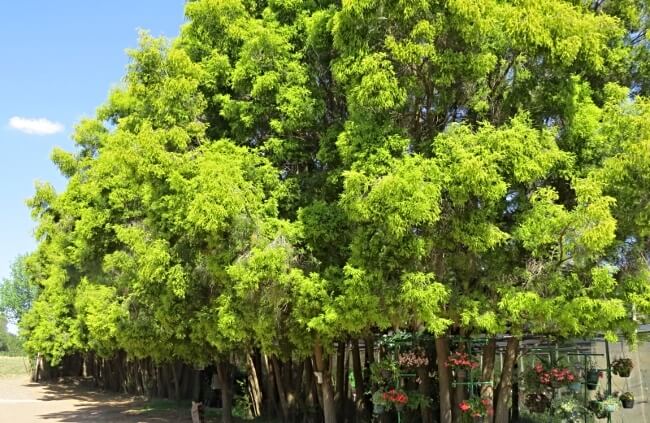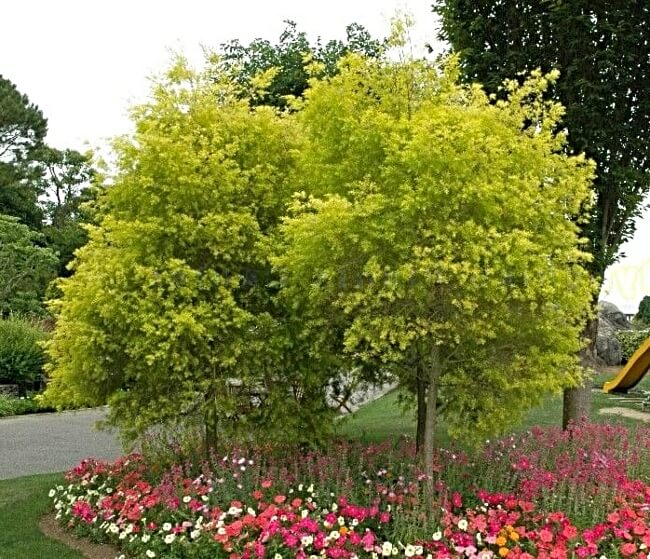My mum has always loved melaleucas. Growing up in southeast Queensland, you couldn’t go far without seeing the distinctive white bottlebrush-like flowers of Melaleuca popping up in masses through the summers.
As a kid playing in the garden, it was like seeing snow in summer! That magical feeling only a few natives can spur in us.
Part of a prized Aussie family of ornamentals, this species sports vibrant and bushy lime-green foliage, masses of fluffy white flower spikes in summer, and a very useful form for topiary gardening.
More...

Source: Muchea Tree Farm
Family: | Myrtaceae |
|---|---|
Genus: | |
Species: | M. bracteata |
Common names: | Black tea tree, river tea tree, white cloud tree |
Origin: | Australian native |
Location: | Outdoor |
Type: | Large shrub to small tree |
Growth: | 2 to 10 metres tall, 2 to 6 metres wide |
Sun requirements: | Full sun to part shade |
Foliage colour: | Green (Evergreen) |
Flower colour: | Cream to white flower spikes |
Flowering: | Spring to summer |
Maintenance level: | Low |
Poisonous for pets: | Plant oil is toxic to cats, dogs, and horses if consumed |
While most melaleucas are carefree plants, this species in particular is cherished for its extremely adaptable nature, having the ability to grow in almost any conditions in Australian gardens.
In today’s guide, I’m thrilled to be covering everything you need to know to grow and care for Melaleuca bracteata in your garden so you can make the most of this special native in your outdoor spaces!
Introducing Melaleuca bracteata
Melaleuca bracteata, also known as the black tea tree, river tea tree or white cloud tree, is native to northern Australia where it occurs commonly in the coastal and inland regions along stream banks and wet sites.
It is a highly adaptable species in cultivation with many exciting garden cultivars that are perfect for smaller outdoor spaces! Some of my favourites include the ‘Revolution Gold’ and ‘Golden Gem’ varieties.
Black Tea Tree Features
Its compact shape and many flowers truly make this native a standout in gardens! Furthermore, it can be grown as a large shrub or a small tree, giving you access to some useful landscaping applications as well.
In terms of its growth, it will typically reach about 2 to 10 metres tall and 2 to 6 metres wide. Size can vary depending on your pruning routine and the growing conditions on-site.
My mum and sister use the tree as a feature in their gardens, but it can also be used for native hedging and screening thanks to its dense foliage. It is also a perfect addition to wildlife gardens as it will attract native bees, birds, butterflies and more!
How to Grow Melaleuca Bracteata
Like its relatives, this species can be propagated using seeds and cuttings. Alternatively, many Australian nurseries stock young plants that can easily be transplanted into your garden.
Growing River Tea Tree from Seeds
Seed is best sown in spring or autumn to avoid the harshest months of the year. Sow the seeds on the surface of a quality potting mix for seeds. Press them lightly into the surface but try to avoid burying them.


Get Your Free Guide:
Master Growing Australian Natives eBook
A Must Have Complete Guide for Every Australian Garden
Get Your Free Guide:
Master Growing Australian Natives eBook
A Must Have Complete Guide for Every Australian Garden
Keep the soil warm and slightly moist at all times. Ideal germination temperatures are between 18-22°C with germination usually occurring within 28 days.
Propagating White Cloud Tree Using Cuttings
Using sharp and sterilised pruning shears, take a semi-hardwood cutting from the current year’s growth in late summer. The cutting should be around 15cm in length. Remove the lower leaves then dip the cut-end into some rooting hormone for cuttings.
Plant the cutting into quality propagation soil mixed with some compost. Water well after planting then keep warm and moist while roots develop.
Growing and Caring for Melaleuca Bracteata
As I’ve mentioned, this species is a true hassle-free addition to Aussie gardens! Once established, the plant is tolerant to a variety of growing conditions, drought, and moderate frosts.
Let’s look at some of the basic growing conditions it needs to thrive and how you can give your shrub some TLC over the years.
Soil Needs for Black Tea Tree
The species tolerates a variety of soils so long as the soil is well drained. A loamy clay soil should work perfectly!
Sunlight
Pick a planting site that gets full sun to part shade. In cooler climates, more full sun is beneficial whereas in hotter climates, some shade may be preferred. Try to give the plant about 6 hours of direct light each day for optimal growth and flowering.
Watering White Cloud Tree
Water well while young and during hot and dry spells. Once established, this native requires minimal supplemental watering.
How to Prune Black Tea Tree
This Melaleuca species responds particularly well to pruning! Because its foliage can get quite bushy, I recommend pruning regularly during the growing seasons and after flowering. This tree can be shaped with ease, allowing you to maintain your desired form and size throughout the years.
Fertilising
The ideal fertiliser for this species is one that has a balanced mix of the three main plant nutrients. Feed during the growing season with a balanced, water-soluble garden fertiliser to encourage prolific flowering and denser foliage.
Pests and Diseases
This hardy species is considered pest and disease-free in Australian gardens.
Melaleuca bracteata Frequently Asked Questions

Source: Windy Willows
What is Melaleuca bracteata used for?
In gardens, this Australian shrub to small tree is prized for its many uses. Its dense foliage makes it an ideal specimen for topiary gardening, but it can also be used as a feature tree, shade tree, or used for native hedging and screening.
What colour are Melaleuca bracteata flowers?
The white cloud tree is known to flower prolifically in good conditions, sporting masses of white to cream-coloured flower spikes from spring to summer. The flowers are bottlebrush-like, textured, and fluffy, able to add gorgeous texture and colour to outdoor spaces!
What are the characteristics of Melaleuca bracteata?
The black tea tree is a bushy-foliaged, small to medium shrub that can also be grown as a tree. It features a rough and dark grey bark, linear leaves that are arranged in spirals on delicate stems, and white fluffy powder puff flowers from October to December in the southern hemisphere.
Enjoy the Elegant Beauty and Resilience of Melaleuca bracteata
So, there you have it, everything you need to know to grow and care for Melaleuca bracteata in your landscape. I adore the Myrtaceae family of plants, and the black tea tree is certainly a standout for gardens looking for some native texture and colour.
Not only will the flowers impress, but the shrub's naturally vibrant evergreen foliage will look fantastic year-round. Melaleuca bracteata and its many stunning cultivars are excellent picks for almost any Australian garden so if you don’t have one already, start growing yours today!
Happy gardening from the AGT Team.
Published on October 18, 2023 by Gary Clarke
Last Updated on September 20, 2025





